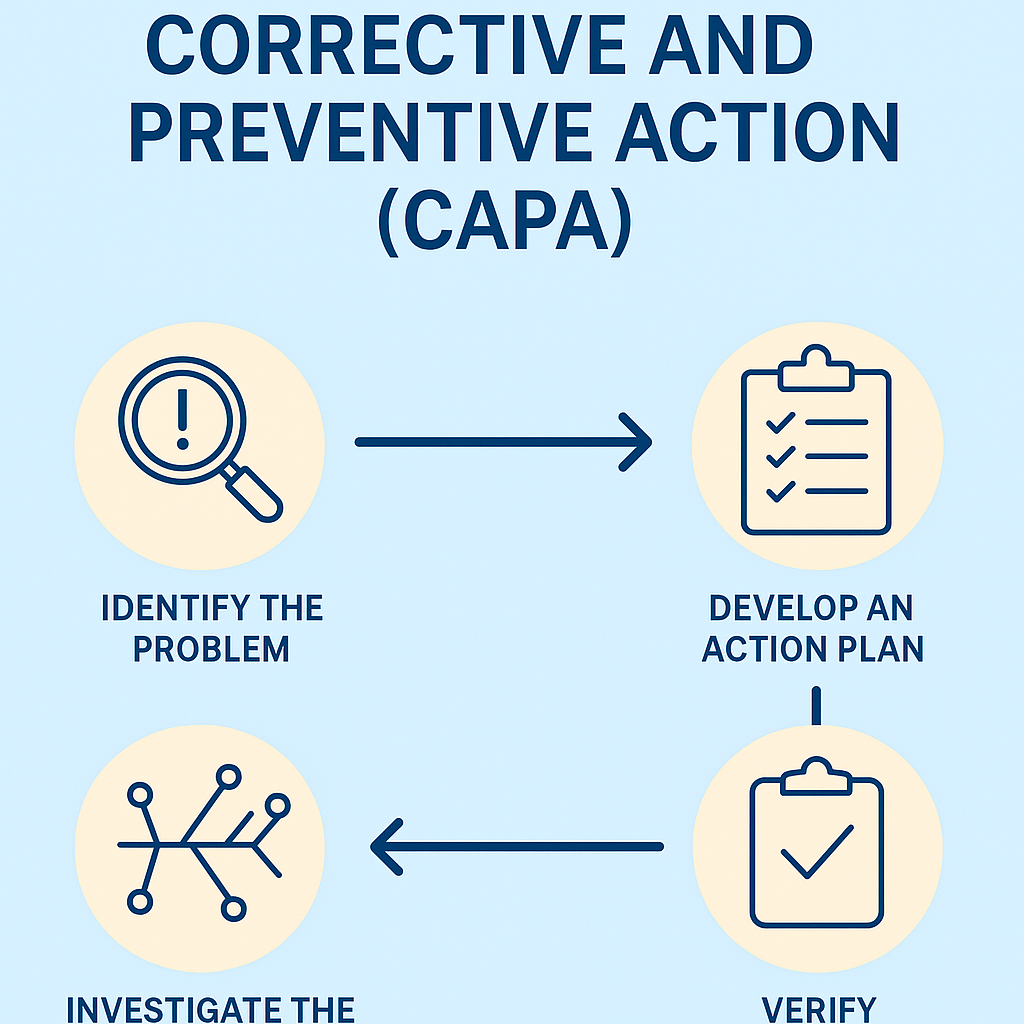What is CAPA?
CAPA stands for Corrective and Preventive Action. It is a critical concept used in quality management systems across industries like manufacturing, healthcare, pharmaceuticals, and food production.
CAPA is a systematic approach to identify, correct, and prevent problems in processes or products. It ensures continuous improvement by addressing both the root cause of current issues (corrective) and preventing recurrence or potential problems (preventive).
Breakdown of CAPA:
-
Corrective Action (CA):
Steps taken to eliminate the root cause of a detected nonconformity or problem to prevent it from happening again. -
Preventive Action (PA):
Steps taken to eliminate the causes of potential nonconformities or issues before they occur.
Steps in a CAPA Process:
- Identify the Problem
- Evaluate the Risk or Impact
- Investigate the Root Cause (e.g., using tools like 5 Whys or Fishbone Diagram)
- Develop an Action Plan
- Implement the Action
- Verify Effectiveness
- Document Everything
- Review and Close the CAPA
1. Identify the Problem
Goal: Clearly define what went wrong or what could go wrong.
How to do it:
- Use customer complaints, product returns, team feedback, or quality checks to spot issues.
- Be specific and write it down as a problem statement.
Example:
"Customers reported that the zipper on the toiletry pouch breaks after two uses."
2. Evaluate the Risk or Impact
Goal: Determine how serious the issue is, and prioritize it.
Questions to ask:
- How many customers were affected?
- Does it risk safety, trust, or income?
- Is it likely to happen again?
Use a Risk Matrix (Low, Medium, High Impact x Likelihood)
Example:
- 1 in 3 buyers are affected.
- It's leading to bad reviews and returns.
- Impact = High → prioritize this CAPA.
3. Investigate the Root Cause
Goal: Discover the real reason behind the problem—not just symptoms.
Tools you can use:
- 5 Whys: Ask "Why?" repeatedly until you reach the root.
Here's a clear and practical table to help you understand the 5 Whys method — a powerful root cause analysis tool that helps you dig deep and uncover the true source of a business problem.
5 Whys Root Cause Analysis – Explained in a Table
| Step | Question | Answer | Explanation |
| 1st Why | Why did the customer return the bracelet? | The beads fell off. | This identifies the immediate issue. |
| 2nd Why | Why did the beads fall off? | The thread unraveled after one use. | We’re getting closer to the cause. |
| 3rd Why | Why did the thread unravel? | The knot at the end wasn’t secured properly. | Now we're discovering a production flaw. |
| 4th Why | Why wasn’t the knot secured? | The team skipped the final tie-and-test step. | The error is in the process. |
| 5th Why | Why did the team skip the step? | There’s no clear SOP or quality control checklist. | 🔍 Root Cause Found – lack of structured process. |
Summary of This Example:
- Problem: Beads falling off a bracelet
- Root Cause: No SOP or checklist to ensure final knotting and quality testing
- Solution (CAPA):
- Corrective: Re-knot and fix returned items
- Preventive: Create and enforce a quality SOP for every batch
When to Use the 5 Whys:
- Product defects (e.g., broken zippers, glue fails)
- Digital product issues (e.g., wrong download link)
- Shipping problems (e.g., late or damaged packages)
- Customer complaints (e.g., unclear instructions)
- Fishbone Diagram (Ishikawa): Categorize possible causes under headings like Material, Method, Manpower, Machine, Environment.
FISHBONE DIAGRAM (ISHIKAWA)
Here's a clear and detailed table to help you understand the Fishbone Diagram (also called the Ishikawa Diagram or Cause-and-Effect Diagram) — a powerful tool you can use to identify the root cause of problems in your business.
Fishbone Diagram (Ishikawa) Explained in a Table
| Element | Description | Example (for Handmade Product Defect: "Beads Keep Falling Off Bracelet") |
| Problem (Effect) | The issue you're trying to solve. This goes at the "head" of the fish. | Beads fall off finished bracelet |
| Main Categories (Bones) | Major areas where causes might come from. Traditionally: People, Process, Materials, Machines, Measurement, Environment | Let's apply these to your business . |
| People (Who) | Human-related causes: lack of training, mistakes, miscommunication | Staff rushed production and skipped bead tightening |
| Process (How) | Step-by-step tasks or procedures that may have flaws | No final quality check after beading |
| Materials (What) | Inputs used: raw materials, supplies, fabrics, etc. | Cheap thread used that can't support bead weight |
| Machines (Tools) | Tools, equipment, or machines involved | Beading needle is worn out and doesn’t tighten beads properly |
| Measurement (Standards) | Lack of clear instructions, measurements, or benchmarks | No clear SOP for checking thread tension |
| Environment (Where/When) | Workspace, lighting, distractions, or temperature | Poor lighting makes it hard to see loose beads |
How to Use the Diagram in Practice:
- Write the problem at the head → e.g., “Beads falling off.”
- Draw a horizontal line (fish spine).
- Add diagonal lines for each category → People, Process, etc.
- Brainstorm possible causes under each category.
- Analyze the causes to find the root ones.
- Create CAPA (Corrective and Preventive Action) based on findings.
Bonus: Example Categories for Fashion/Handmade Businesses
| Category | Tailored Examples for Your Business |
| People | Lack of staff training, distractions, fatigue |
| Process | No quality check step, unclear beading order |
| Materials | Weak glue, poor-quality thread or fabrics |
| Tools | Dull scissors, malfunctioning glue gun |
| SOP/Measurement | No measurement guide for rhinestone spacing |
| Environment | Crowded work area, bad lighting, no air ventilation |
Example (5 Whys):
- Why did the zipper break? → It got stuck.
- Why did it get stuck? → The fabric folded into the zipper.
- Why did fabric fold? → It wasn’t stitched flat.
- Why? → The sewing template isn’t properly aligned.
- Why? → Staff skipped the alignment step to save time.
Root Cause: Incomplete production procedure + lack of training.
4. Develop an Action Plan
Goal: Create a step-by-step plan to fix the root cause and prevent recurrence.
Include:
- Corrective Actions (fix the current issue)
- Preventive Actions (avoid future issues)
- Who is responsible
- Deadlines
Example:
- Re-align sewing templates immediately (Corrective)
- Retrain staff with visual SOP (SOP stands for Standard Operating Procedure.)and checklist (Preventive)
- Quality control will inspect first 10 units per batch
- Responsible: Production Manager
- Due: This week
5. Implement the Action
Goal: Carry out the plan.
Tips:
- Make sure all team members are informed.
- Allocate time and resources.
- Test actions in a small batch before full rollout.
Example:
Retrain team over two days, print out updated sewing SOP, conduct first new quality check batch.
6. Verify Effectiveness
Goal: Confirm that the issue is resolved and won’t return.
How to do it:
- Monitor returns, customer feedback, and team performance.
- Compare before and after results.
- Get feedback from your team or even test orders.
Example:
After retraining, 3 new batches showed 0 zipper defects and no customer complaints in 30 days
7. Document Everything
Goal: Create a paper or digital trail for future reference, compliance, and continuous improvement.
What to include:
- The original problem statement
- Root cause analysis
- Action plan with dates and names
- Implementation notes
- Before/after metrics
- Proof of effectiveness
Tool: Use a CAPA Log in Notion, Excel, or printable PDF
8. Review and Close the CAPA
Goal: Formally complete the process and log your learnings.
Checklist:
- Have all actions been completed?
- Are results acceptable?
- Is the issue resolved long-term?
- Can you improve other areas with this learning?
Example:
Review confirmed that updated SOP + training worked. CAPA is closed. Next: apply this checklist to all new bag designs.
Implementing this CAPA process not only helps solve problems—it trains your team, protects your brand, and builds a proactive business culture where quality and customer care come first.
Examples:
- A company finds defective packaging on a product batch.
- Corrective Action: Fix packaging machine and retrain staff.
- Preventive Action: Schedule routine maintenance and update packaging SOP.
STANDARD OPERATING PROCEDURE.
SOP stands for Standard Operating Procedure.
It’s a step-by-step written instruction that outlines how to perform a specific task or process consistently, safely, and effectively.
Why SOPs Matter in Business:
| Benefit | Description |
| Consistency | Ensures tasks are done the same way every time (no matter who does it). |
| Training Tool | New team members can follow the SOP to learn tasks faster. |
| Quality Control | Helps maintain a high-quality standard across products and services. |
| Efficiency | Saves time by eliminating confusion or guesswork. |
| Accountability | Everyone knows what’s expected—and what “done right” looks like. |
Example for Your Handmade Business:
SOP: Creating a Fabric Pouch Bag
| Step | Action |
| 1 | Cut fabric to 9" x 6.5" using template |
| 2 | Sew the lining to the outer fabric |
| 3 | Add zipper 1" below top edge |
| 4 | Attach decorative 3D flowers and rhinestones |
| 5 | Perform quality check (zipper test, stitch strength) |
| 6 | Package in a branded bag with care card |
Common Types of SOPs You Can Use:
- Product Assembly SOP – for handmade jewelry, soaps, bags
- Packaging SOP – how to prepare items for shipping
- Customer Service SOP – how to respond to complaints or questions
- Marketing SOP – steps to schedule social posts or send emails
- Vendor/Inventory SOP – how to reorder materials
Why CAPA Is Important for Your Business
1. Reduces Recurring Problems
Explanation:
Without a structured system like CAPA, you might fix the same problem multiple times—wasting time, money, and energy. CAPA helps identify the root cause of issues and eliminates them permanently.
Example:
If your customers often complain that the beads on a bracelet fall off, and you only replace the product without fixing the actual problem (e.g., poor glue or rushed assembly), it will keep happening. CAPA stops the cycle.
2. Improves Product Quality
Explanation:
By correcting and preventing defects, your final product becomes more reliable and consistent. This builds trust and a reputation for quality.
Example:
Switching to a higher-grade adhesive after a rhinestone issue doesn’t just fix one item—it improves all future products, making them more durable and premium.
3. Ensures Regulatory Compliance (e.g., FDA, ISO)
Explanation:
If you're working in fields like beauty, skincare, food, or anything with health implications, CAPA is often required to meet regulations. Even if you're not regulated, adopting CAPA shows professionalism and readiness for growth.
Example:
If your handmade soap business grows and you want to sell to stores or export, having a documented CAPA system puts you ahead. It shows you're serious about safety and quality.
4. Boosts Customer Satisfaction
Explanation:
Customers love brands that listen, take responsibility, and improve based on feedback. CAPA helps you do this proactively—not just when someone complains.
Example:
If a customer says the zipper pouch lining tore, and you update the material + respond professionally, they’re more likely to buy again and recommend your brand.
5. Saves Time and Cost in the Long Term
Explanation:
Fixing problems at the source reduces waste, refunds, lost customers, and rework. While CAPA takes effort upfront, it saves you money over time and protects your business reputation.
Example:
Let’s say you spend 5 hours a week fixing product errors. A one-time CAPA process might cut that to 30 minutes/week—saving you 15+ hours/month and reducing material waste.
Summary for You:
CAPA = Smart, Proactive Growth.
It’s not just about fixing what’s broken; it’s about building a stronger, more efficient, and trustworthy business that customers can depend on.
Applying CAPA (Corrective and Preventive Action) to your business can significantly improve your quality, customer satisfaction, and efficiency—whether you're managing handmade products, digital templates, or subscription boxes.
Here’s a practical guide tailored to your businesses:
Where CAPA Can Apply in Your Business:
| Area | Example Problem | Corrective Action | Preventive Action |
| Product Quality | Beads falling off a bracelet | Reinspect and fix batch, retrain staff | Update SOP, use stronger adhesive, implement quality checks |
| Digital Product | Customers complain PDF isn't downloadable | Fix link, resend access | Add QA checklist before publishing |
| Customer Service | Delay in responding to inquiries | Respond and apologize | Set up chatbot or auto-reply system |
| Order Fulfillment | Wrong item shipped | Resend correct item | Implement an order checklist system |
| Marketing | Low email open rates | Redesign subject lines, segment list | Test before launching campaigns regularly |
| Shipping | Package damaged in transit | Offer refund/replacement | Upgrade to better packaging materials |
Steps to Apply CAPA in Your Business:
1. Identify the Issue
- Collect complaints, reviews, or observe flaws.
- Example: “Multiple customers said the rhinestones fell off after one use.”
2. Investigate the Root Cause
- Use the 5 Whys technique:
- Why did rhinestones fall off? → Weak glue.
- Why weak glue? → Switched to cheaper supplier.
3. Take Corrective Action
- Fix current orders or customer issues.
- E.g., Refund affected customers and redo affected products.
4. Plan & Apply Preventive Action
- Make sure it doesn’t happen again.
- Find a better supplier.
- Test adhesives before full production.
- Update your product creation checklist.
5. Verify & Monitor
- Check if the issue is resolved permanently.
- Review customer feedback after implementing fixes.
6. Document Everything
-
Keep a CAPA log in Notion, Excel, or your CRM.
GEMBA
What is GEMBA?
Gemba (現場) is a Japanese term that means "the real place" or "where the work happens." In business—especially in lean manufacturing, quality control, and process improvement—Gemba refers to the actual location where value is created.
For example:
- In a fashion accessory business, the Gemba might be your workshop or packaging station.
- In retail, it’s the storefront.
- In digital businesses, it might be your backend system or customer support interface.
Why Gemba Is Important
The concept is tied to "Gemba Walks"—where leaders or quality managers go to the worksite to:
- Observe the process
- Identify waste
- Ask questions
- Listen to employees
-
Improve performance on the spot
Gemba = See + Ask + Improve
| Principle | Description |
| Go See | Visit the actual site of work. Don’t just rely on reports. |
| Ask Why | Talk to the people doing the work—understand their pain points and ideas. |
| Show Respect | Engage respectfully with team members. Their insight is invaluable. |
Example in Your Handmade Business:
If your team is packaging orders and you notice delays or frequent mistakes, doing a Gemba Walk might reveal:
- Lack of space or poor layout
- Missing tools (e.g., scissors, tape)
- Confusion over order checklist
Instead of guessing, you're observing and solving problems at the source.
Gemba Helps You:
- Improve quality and reduce defects
- Spot inefficient steps
- Understand root causes
- Empower team members
- Strengthen processes before scaling
How to Apply GEMBA in Your Business
1. Identify Your “Gemba”
Gemba is the place where the work happens and value is created.
Examples of Gemba in your business:
| Business Area | Gemba Location |
| Handmade jewelry/accessories | Worktable, materials corner, packaging area |
| Digital products/templates | Your design screen, Notion or Canva workspace |
| Order fulfillment | Storage shelves, shipping station |
| Customer service | Email inbox, DMs, chatbot interface |
| Marketing/Social | Content creation desk, analytics dashboard |
2. Do a Gemba Walk (or Review) Weekly or Monthly
Take time to observe the process—not just the results.
What to look for:
| What to Observe | Examples |
| Workflow steps | Are steps being skipped or done twice? |
| Tools & materials | Are they easy to reach? Are they causing slowdowns? |
| Employee or self-experience | Are you/your staff frustrated at any stage? |
| Environment | Is the space cluttered, poorly lit, or disorganized? |
| Mistakes/defects | What's causing product returns or complaints? |
3. Ask Questions Respectfully
Whether it's your team or your own solo workflow, ask:
- "What slows this process down?"
- "Why is this mistake happening?"
- "What tool or checklist would make this easier?"
Use 5 Whys or a Fishbone Diagram if needed.
4. Take Notes and Identify Wastes
Use the LEAN 7 wastes framework (TIMWOOD) to spot inefficiencies:
| Waste Type | Example in Your Biz |
| Transport | Constantly moving supplies between rooms |
| Inventory | Overstocking beads or fabrics |
| Motion | Reaching across the room for scissors |
| Waiting | Waiting for glue to dry without batching |
| Overproduction | Making 50 pouches when only 10 are ordered |
| Overprocessing | Rechecking labels 3x without reason |
| Defects | Rhinestones falling off due to weak adhesive |
5. Apply CAPA (Corrective and Preventive Action)
Use what you observed to:
- Fix current issues (corrective)
- Prevent them in the future (preventive)
Examples:
- Install a wall organizer for tools → reduces motion waste
- Add a checklist to packaging area → reduces defects
- Rearrange workspace for smoother flow → improves speed
6. Repeat and Improve Continuously
Gemba is not a one-time thing. Make it a habit—walk your processes regularly, especially when:
- You're adding a new product
- Complaints increase
- You want to scale or train someone else





